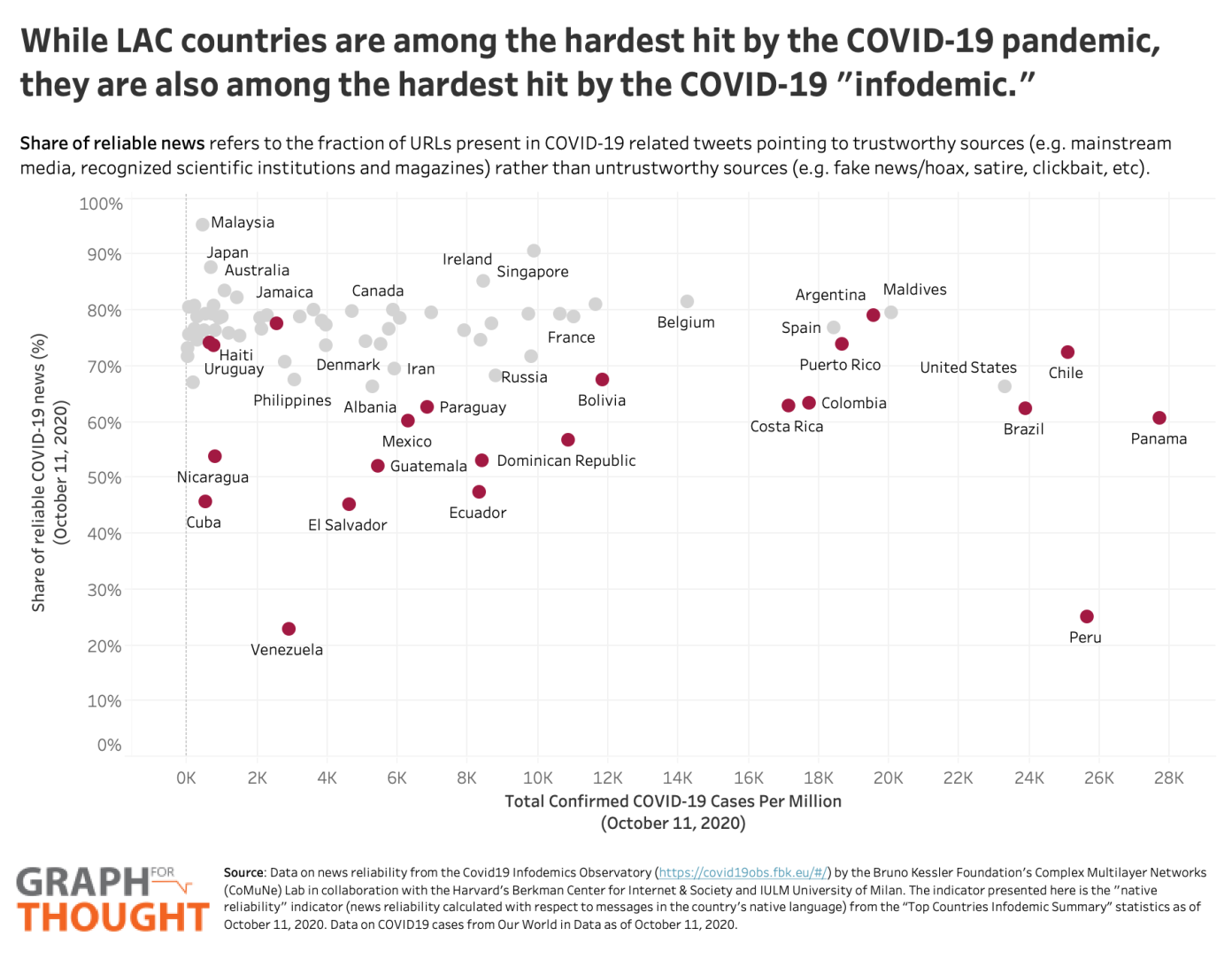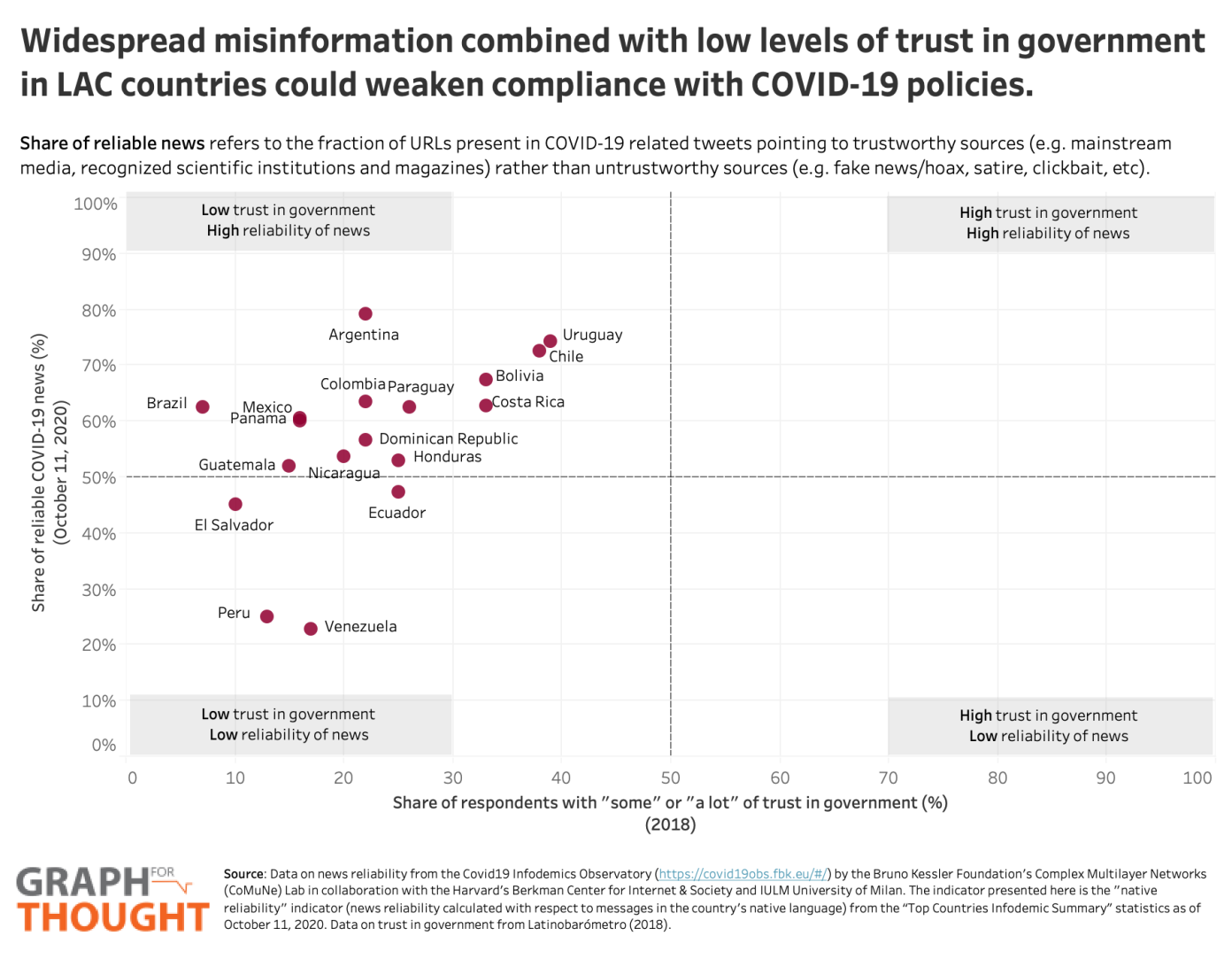Where the pandemic meets the infodemic: The challenge of misinformation in the fight against COVID-19 in LAC
October 20, 2020
In his remarks at the Munich Security Conference on February 15, 2020, WHO Director-General Dr Tedros Adhanom Ghebreyesus astutely noted one of the many parallel battles that COVID-19 brought with it: the battle against mis- and dis- information. As he acknowledged, “we’re not just fighting an epidemic; we’re fighting an infodemic. Fake news spreads faster and more easily than this virus, and is just as dangerous.”
Indeed, as COVID-19 has spread across the world, so too has false information about it. In this context, false information, usually created to increase user engagement in certain platforms with click-bait headlines, could be a matter of life and death if it encourages people to ignore public-health advice, fosters discrimination or violence, or advocates for the use of untested remedies. As UNDP Administrator Achim Steiner has stated, this type of information environment may result in not only “undermining the effectiveness of public health measures, but also leading to real life violence and discrimination, confusion, fear and, arguably, long-term societal harm.”
Drawing on cross-country data from the Bruno Kessler Foundation’s Covid19 Infodemics Observatory, this #GraphForThought explores the spread of false COVID-19 information in LAC and reflects on how it may interact with the region’s existing structural deficits in trust in institutions. Using a massive global dataset of COVID-19 related posts on Twitter, the Observatory uses machine learning techniques to quantify indicators such as “news reliability”—the fraction of URLs pointing to trustworthy sources (e.g. mainstream media, recognized scientific institutions and magazines) rather than untrustworthy sources (e.g. fake news/hoax, satire, clickbait, etc). As of October 11, 2020, the Observatory had analyzed over 519 million COVID-19 related posts on twitter (beginning January 21, 2020)—and found that at the global level, the majority of posts (71%) were classified as sharing “reliable news.” The situation is less rosy, however, if we zoom in to the LAC region.
The Observatory provides summary statistics for 83 countries—and as of October 11th, the 15 lowest ranking performers on this list in terms of news reliability were all in LAC. The data show that on average in LAC countries, just 59% of news is considered reliable—although there is wide heterogeneity. While in countries such as Argentina and Jamaica almost 80% of news is considered reliable, in countries such as Venezuela and Peru this share drops to a staggering 25% or less. This implies that in Venezuela and Peru, only 1 out of every 4 tweets contains reliable news—by far the lowest rates of news reliability globally. It is important to remember, however, that the battle against misinformation was already taking shape in LAC prior to COVID-19—a “pre-existing condition” that left the region vulnerable to the infodemic it is experiencing now. If we consider which countries have been hardest hit by the infodemic (looking at overall news reliability) and which have been hardest hit by the pandemic (looking at total confirmed COVID-19 cases per million)—we see that many LAC countries (shown on the graph in purple) have unfortunately been hit hard by both. b

Moreover, false information has the potential to be even more dangerous in contexts with pre-existing low trust in institutions. A study by the Reuters Institute found that the most common type of COVID-19 misinformation is false claims about actions or policies that public authorities (such as individual national/regional/local governments, health authorities, and international bodies like the WHO and UN) are taking to address COVID-19. As the authors of this study note, “in the absence of sufficient information, misinformation about these topics may fill in gaps in public understanding, and those distrustful of their government or political elites may be disinclined to trust official communications on these matters.”
In context of LAC, where trust in government was already low and declining prior to the pandemic, this could present a particular challenge. For example, as the figure below shows, in a few LAC countries we are seeing a potentially dangerous combination of “low” levels of pre-existing trust in government and “low” levels of reliability of news (such as in Venezuela, Peru, El Salvador, and Ecuador). This has the potential to worsen the spread of COVID-19, as it may weaken public compliance with containment policies. As Larson and Heymann note in their commentary on the Public Health Response to Influenza A(H1N1) as an Opportunity to Build Public Trust, “times of uncertainty and risk are times when public trust is most needed. But trust is built long before the time that trust matters most.”

The link between (dis)trust, (mis)information, and (non)cooperation also has feedback effects. Where compliance is weak and disease outbreaks fail to be contained, this has the potential to reinforce low levels of trust in institutions due to a perceived lack of “outcome legitimacy” (derived from perceptions of effective delivery of policy promises)—thus propelling a vicious circle of low-trust and low-compliance. However, the converse is also true. In this way, the pandemic presents an opportunity to break a cycle of low trust (to reap a “trust dividend”) if governments are able to collaborate with trusted actors to develop an effective communication strategy to combat misinformation and flood the system with “good” advice, thus promoting public cooperation and positive outcomes.

 Locations
Locations